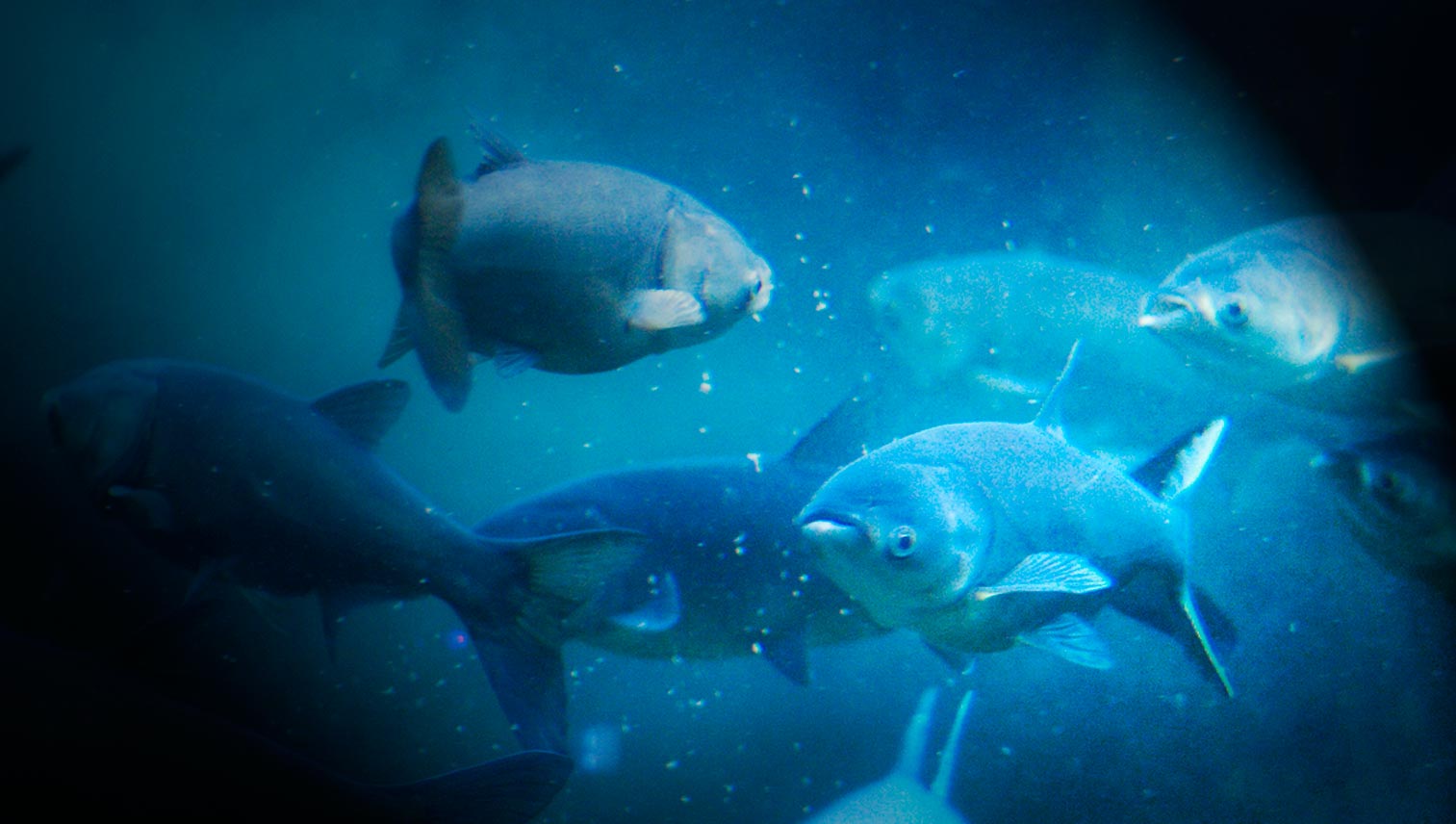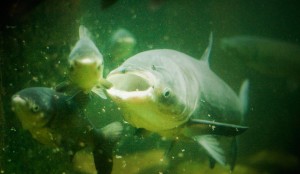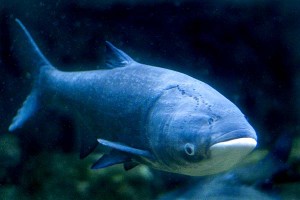By Brian Kozminski
A female Asian Bighead Carp can lay 2 million eggs a year. What does that mean for the future of Lake Michigan?
I live in northern Michigan, epicenter of the world’s largest freshwater system.
Twenty percent of the world’s fresh water surrounds us, and that’s great. It provides us multiple uses for recreation. Swimming, boating, canoeing, kayaking, sailing, SUP’s, and fishing. When I ask people from neighboring states where they like to go fishing, they always say they head up north and fish Michigan’s rivers and lakes. But, recent news of more eDNA, from Asian Carp, found in the Chicago shipping canal has me concerned.
How many more years are we going to spend doing research, wasting millions of dollars, looking for a way to prevent the impending doom of their arrival in the Great Lakes? If they do arrive, or [GASP] are already here in the Great Lakes, what amount of devastation will they cause on a billion-dollar fishery? Will anglers from the Midwest still come up and fish the Pere Marquette for salmon and steelhead?
We’ve been here before, invasive species are not a new thing. In fact, we have almost 200 invasive species of flora to fauna in the Great Lakes. We’ve been battling the sea lamprey since the late 40’s when the Welland Canal opened and nearly decimated a thriving Lake Trout and Whitefish fishery in less than half a decade. These days the FWS spends millions of dollars a year on research and containment of the vampire of the Great Lakes.
New residents from the Black and Caspian Seas have also taken hold in Lakes Michigan, Huron, Ontario, Erie and Superior. Round Goby and Eurasian Ruffe out-compete the common darter and native sculpins in the deep waters we love. They have a voracious appetite for eggs and have targeted smallmouth beds. Smallmouth bass have retaliated, finding a new flavor of the month, but can’t keep their population in check.
Zebra and Quagga mussels liter the fresh water sea floor, estimated at 4 quadrillion. Trying to wrap my mind around that number makes my medulla oblongata ache. Sure, they’ve filtered out the water in Lake Charlevoix and Lake Michigan, made it pretty and clear so we can see depths of 30 feet, but we need the phytoplankton in the food chain. This is where the story gets interesting.
Let’s pretend the Great Lakes are a child’s aquarium.
You can only have ‘X’ amount of fish and organisms living inside a contained body of water. For simplicity, let’s pretend you have a 20 gallon aquarium representing Lake Michigan; you can have 20 one -inch fish, you can have 10 2-inch fish, or you can have five 4-inch fish. The aquarium can only hold ‘Y’ amount of food to support the food web, from basic plankton to higher-end organisms. When you take out the basic plant nutrients many organisms depend upon, your top level feeders will disappear.
Enter the Asian Carp: the Silver, Grass and Bighead carp. Their names are kind of misleading because they really are big minnows. They don’t feed on the bottom like other carp that we know in the Midwest . These guys are filter feeders that eat phytoplankton, plankton and diatoms. You can almost think of them as the whale shark of the freshwater seas. They can consume 20 to 25 percent of their body weight a day in micro-organisms (plants), and they grow at extremely fast rates, making them undesirable as a food fish for other predators.
A female bighead carp can lay 2 million eggs a year. Within a couple years, that offspring can be a 100 pound, 5 foot long fish. Humans, by mature, have a need to tinker with the ecosystem. We wipe out or extirpate species, as we have with the Grayling, Passenger Pigeon and other native species in Michigan. We plan others, like salmon, introduced in the 60s to control the Alewives which were introduced via ships ballast water and the German brown trout which was first planted in 1884 in the Baldwin River. Some would like to see the Great Lakes restored to the natural balance before we introduce other species.
Can the Great Lakes ever rebound if we do that? Is there a safe method to completely wipe out everything and restoring the balance?
The situation is complicated by a $1.5 billion industry in shipping through the Chicago canal. A half mile long electrical barrier was built in 2006 after hundreds of thousands were spent on research and safety. This eleventh hour fail safe electrical barrier on the Calumet River cost $20 million and runs $40-$60,000 per month in electric bills. It is, however, feared that young of the year carp may be small enough to bypass this system.
The Great Lakes support $160 million in fishing alone, not to mention the jobs that are created for recreational use-sales of boats, jet skis, canoes, kayaks etc. How many people are going to be jet skiing on Lake Charlevoix if they get hit with an 80-pound Bighead carp? In Illinois, they have thought of creating a demand for the Asian Carp as a delicacy. This seems tricky. If we create a demand we are giving value to something that we plan on wiping out. What happens then?
Thompson Fishery has been marketing carp as fishcakes and sales have been growing. They are selling their Asian fish patties overseas and to restaurants in the south. They are bony, but the flesh is actually tasty and good; not that I can say from experience. Chef Phillipe Parolla from New Orleans believes that with a naming strategy aka ‘Silver Fin’, he can make the Asian carp more palatable in American cuisine.
There may be a silver lining in all this cloud of doom. Just like the smallmouth getting fat gorging on Gobies and Ruffe’s, and the Gobies eating the Zebra Mussels. The highly filtered Great Lakes might not be a suitable home for the Asian Carp. The lack of plankton and phytoplankton from many years of filtering may not offer them a sustainable food source.
Do we dare risk finding out?
Contact your local and State Representatives, let them know how much your Great Lakes mean to you.
Check out,





As an Aussie all I can say is good luck. We have the European Carp and Tilapia and it is a loosing battle.
Man…It’s like sombody is telling me something. this is the third time this week I have read or watched somthing about this. I grew up in Michigan as well and my folks had a place on round lake…so i spent my childhood on Lake Michigan and Charlovoix. It kills me to think that this amazing place could be so badly damaged. thanks for keepig it top of mind.
I live in the epicenterof this invasion and has taken a huge toll on the Illinois fishery. But we have found some ways to make this a sport fish. Here in central Illinois we have a tournament call The Redneck Fishing Tournament, held in Bath, IL (look it up on YouTube) and some outfitters have taken up the sport of bow fishing for the Asian carp.
I thought we were already calling them “Kentucky Tuna”.
Definitely a hot issue and a great article Koz! Hopefully more awareness will spread the word and need for more aggressive counter measures to try and at least slow the progress of Invasive species like Asian Carp.
Pingback: Opinion: Over 200 invasive species in our Keystone Fishery | Fly Life Magazine
Pingback: Tippets: Top Pick Nymphs, Asian Carp Moving Closer, Seven Knots | MidCurrent